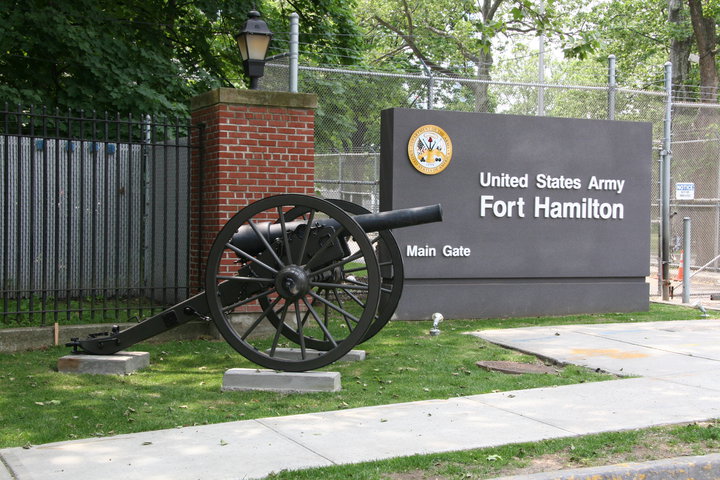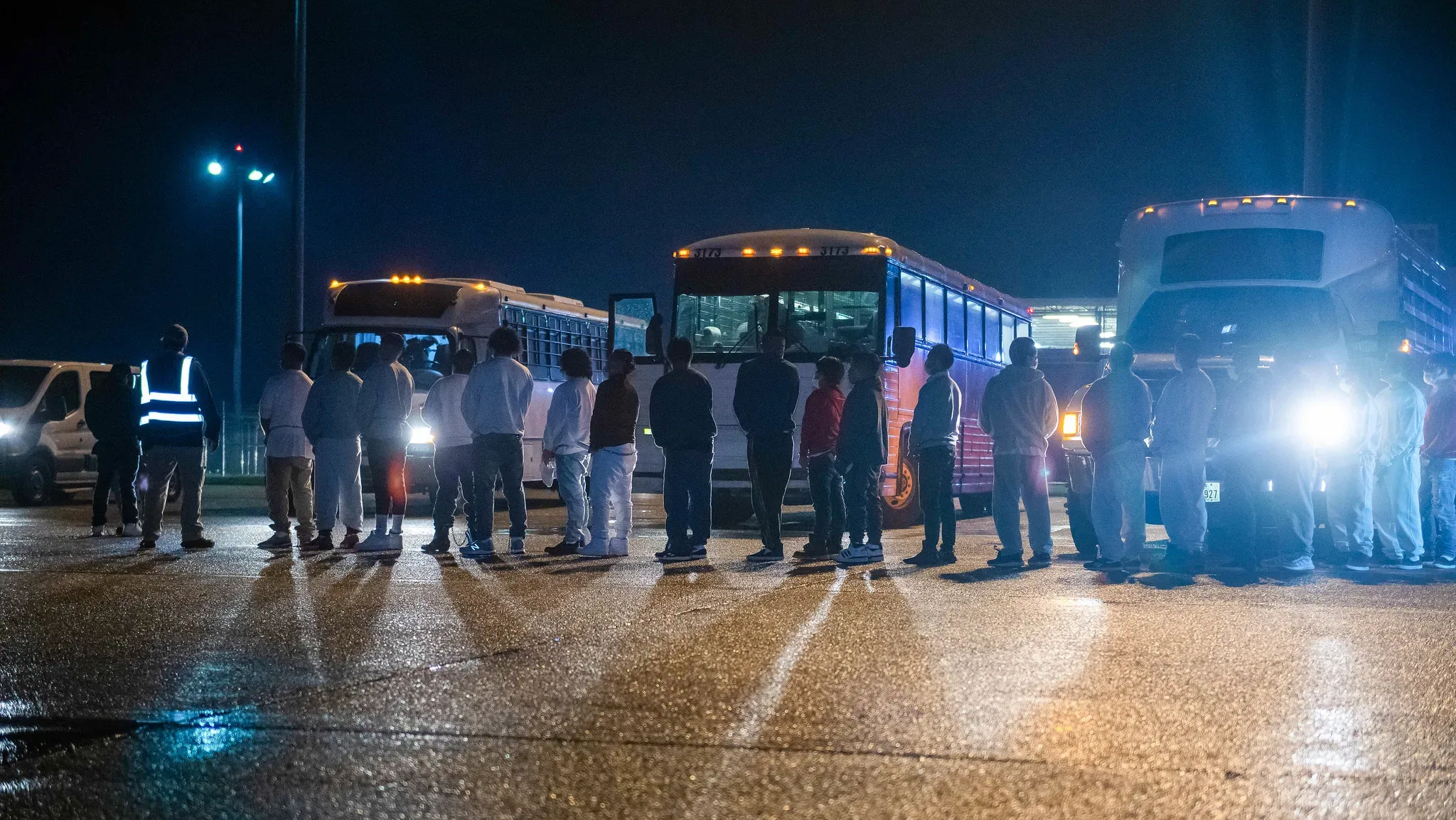In June, Pablo Villavicencio, an undocumented immigrant who had applied for a green card and is married to a U.S. citizen, was detained while delivering pizza to the Fort Hamilton Army base in Brooklyn and held for 53 days. While he had previously delivered food to the base without incident, this time he was detained under a 2009 Department of Defense directive called (DTM) 09-012, “Interim Policy Guidance for DoD Physical Access Control.”
The memo created the legal authority for military bases to vet the identities of visitors seeking “unescorted access” and to have their “fitness” to enter evaluated by checking the National Crime Information Center and Terrorist Screening databases. The memo authorizes bases to use “other sources as determined by the DoD Component” which can include checks with Department of Homeland Security agencies that could reveal immigration status and warrants.
In Villavicencio’s case, Ft. Hamilton discovered that an outstanding active Immigration and Customs Enforcement warrant was on file, a Fort Hamilton spokeswoman told the New York Post. Maragarito Silva and Concepción Barrios, a Brooklyn couple, were arrested under similar circumstances on the Fourth of July as they tried to visit their Army sergeant son-in-law in Jefferson County’s Fort Drum.
Fort Hamilton spokesman Bruce Hill told Documented that the base’s commanding officer had not ordered the use of DHS databases as part of the security protocols, but he could not explain why they were used in Villavicencio’s case.
Asked for any written policies governing access to the base, Hill said, “that’s all you’re going to be getting” and remarked that he had been instructed by superiors not to discuss the issue further. He added that the background check which turned up the ICE warrant had been used to allow Villavicencio to enter the base without proper ID, but also stated that no one without valid ID could be allowed on the base.
Villavicencio had reportedly entered the base in the past using his IDNYC card issued by the city. But now the military apparently is no longer accepting such IDs.
Indeed, the IDNYC cards issued by the city do not seem to meet the criteria laid out in DTM 09-12’s Attachment 4, which contains approved types of identification. Maria Njoku, an Army spokeswoman, confirmed that access to Army installations requires identifications that conform to the requirements of the REAL ID Act of 2005 and that IDNYC cards don’t qualify.
Access to Army installations is not typically controlled by active-duty military personnel, Njoku said. Instead, access is handled primarily by the Department of the Army Security Guards (DASG), a civilian federal law enforcement agency. At larger installations, these officers can be supplemented by other types of defense department personnel, but Fort Hamilton is very small as far as Army bases go.
“The Army Civilian Police and Security Guard Program,” a handbook which lays out the current procedures, policies, and authorities governing the programs, features a section titled “Authority,” which says that DASG and Civilian Police (DACP) officers “can apprehend any persons found on the installation or activity for offenses committed on post that are felonies, misdemeanors, breaches of the peace, a threat to property or welfare, or detrimental to good order and discipline.” It is not clear if an outstanding civil immigration warrant satisfies any of these conditions.
The handbook adds that “such apprehension authority is limited to issuing citations and turning the subject over to the appropriate civilian or military authorities,” apparently allowing civilian officers to at least theoretically turn an immigrant over to ICE.
When asked what a background check could flag that would trigger a detention, Njoku wrote, “if the vetting of an individual reveals derogatory information, government law enforcement personnel contact the originating law-enforcement agency to determine disposition of the individual. People who are denied unescorted access to a military installation due to past criminal histories are free to leave the post or apply for redress.”
In public statements, Fort Hamilton spokespeople have said that Villavicencio signed a form authorizing a background check and that this is standard procedure. Villavicencio has denied that he signed a waiver. While the 2009 directive stipulates requirements for background checks, it does not say that these are to be used if someone requesting access does not have adequate identification, and it doesn’t contain a reference to requiring prospective visitors to sign anything.
On a recent visit to Fort Hamilton, a Documented reporter presented the DACG officers with his IDNYC card and was told that such identification was not acceptable. After presenting a New York State ID card, the reporter was allowed to enter and head to a sign-in area inside a dedicated building. What appeared to be a non-uniformed civilian employee checked the ID.
An Army reservist who had agreed to take the reporter on a tour of the base explained the purpose of the visit to the employee, who waved him through. The identification was stamped to show that the reporter was a noncitizen of the United States, but he was not asked to sign any form beyond a sign-in book and apparently did not undergo a background check.
In an attempt to untangle the questions of jurisdiction and authority raised by the arrests, Documented contacted several experts in military law, jurisdiction, and federal authority from around the country. Kent Eiler, the director of the Veterans Assistance Project at the City Bar Justice Center, said that the question of whether military employees, including their civilian law enforcement components, are permitted to hold an immigrant for ICE is simply not settled.
The Uniform Code of Military Justice states that authorized personnel may take someone into custody “upon reasonable belief that an offense has been committed and that the person apprehended committed it,” but that language is so vague that an Army personnel’s arrest of a civilian over a civil immigration offense could be unlawful, Eiler said.
In addition, under the legal doctrine of posse comitatus, codified in a post-Civil War era law , the government is limited in its ability to use “any part of the Army or the Air Force” as a deputy “to execute the laws.” Eiler said that he thought litigation would be needed to determine if the doctrine prevented the Army from acting as an ICE enforcer.
The DASG/DACP handbook does state that “because of potential conflicts of interest and issues with 18 USC 1385 (The Posse Comitatus Act), it is Army policy that DACP/SGs will not be deputized or exercise any additional authority or jurisdiction granted by local, state, or Federal Governments to perform law enforcement duties on or off a military installation or facility while wearing the duty uniform and/or badge.” An ICE spokesperson didn’t respond to questions about any formal enforcement arrangement between ICE and the Army.
Villavicencio’s lawyers won his release from ICE detention through a federal court order after a judge agreed that he had a right to complete his pending applications before the United States Citizenship and Immigration Service. The issue of the manner of his detention has not arisen in court.
City Council member Justin Brannan, whose district contains the base, said that the arrest seemed arbitrary and questioned whether the decision to detain was made by a gate officer who was just having a bad day. “Clearly here it looks like they were going far beyond what their job is supposed to be,” he said.
He also wondered why, if Villavicencio did not have the proper identification, he wasn’t just turned away. “If I don’t have a ticket to a show, they don’t then pull me inside and say ‘we’re going to arrest you because you don’t have a ticket,’ they say ‘you don’t have a ticket, get the hell out of here.’”
In a statement, Brooklyn Borough President Eric Adams said “there is real cause for concern that DOD officials have engaged in on-the-ground mission creep pertaining to civilian detention around its bases, notably recent incidents at Fort Hamilton and Fort Drum” and called for Congressional oversight hearings that would provide “clarity on roles and responsibilities.”
Ultimately, until the courts or Congress intervene, it seems that there is little in the way of a centralized, accessible policy governing cooperation between Army security personnel and federal immigration enforcement authorities. Rather, there appears to be a patchwork of regulations and determinations at multiple levels of the command chain, including by individual DASG and DACP officers.
Immigrants with status issues hoping to enter military installations, it appears, will just have to roll the dice.














